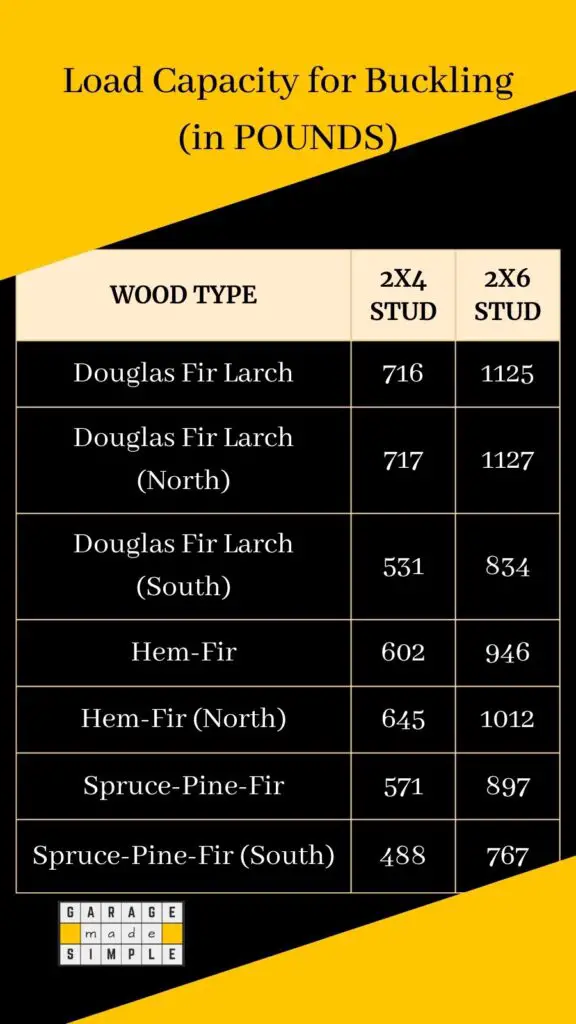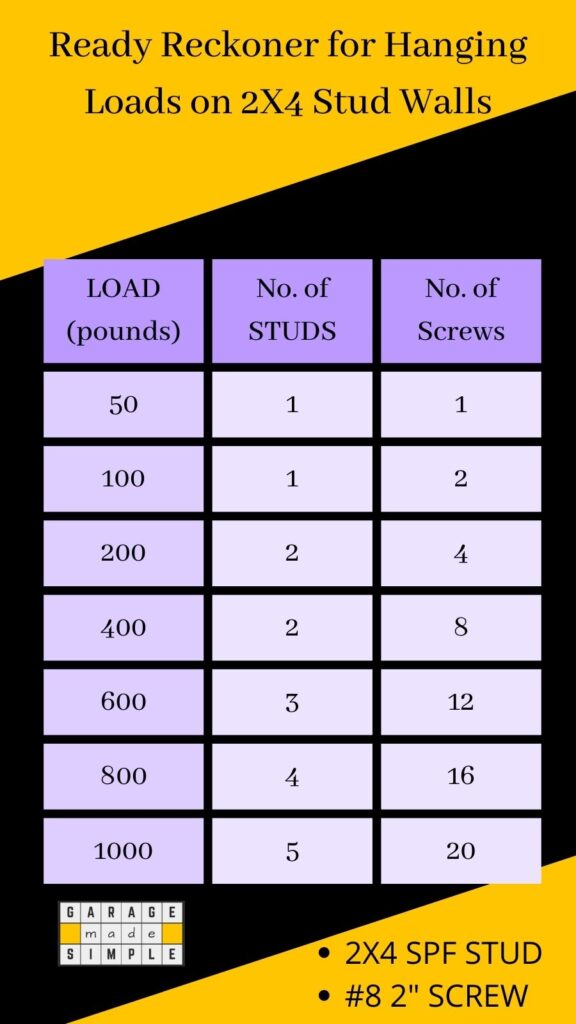2×4 Wall Load Bearing Capacity: A Comprehensive Guide for DIYers
garagemadesimple.com is a participant in the Amazon Services LLC Associates Program, an affiliate advertising program designed to provide a means for sites to earn advertising fees by advertising and linking to Amazon.com . The website is also an affiliate of a few other brands.
How Much Weight Can a 2X4 Wall Hold?
There can be any number of reasons to know the 2X4 wall load bearing capacity. You may want to hang stuff like cabinets, tool racks or a TV on your garage wall. So you have to know how much weight can a 2X4 wall hold?
You can safely hang 600 pounds on a 2X4 stud wall provided you distribute the load over 3 studs, use 12 #8 2 inch construction screws as fasteners and keep the load close to the garage wall.
Following are some of the factors that determine the calculated 2X4 wall load bearing capacity of the garage wall framed with wood studs:
- Width of the wall which determines the number of studs (usually spaced 16″ OC)
- Stud dimension (usually 2X4, though sometimes 2X6 may be used)
- Height of the stud (a standard garage has a 8′ high wall)
- Type of wood used (spruce, pine, fir are commonly used)
- Type of fastener (construction screws can hold more than nails)
- Stud dampness level

When an item is hung on a garage wall it creates a shear load on the fastener (nail or screw). The shear load is the weight of the object being pulled down by gravity and trying to produce a sliding failure in the fastener.
The load also tries to pull the fastener out of the stud like a hammer claw. This is the “pull out” load or the “withdrawal” load.
In addition the load of the item is also trying to twist the stud along its vertical height. This is the torque on the stud which can warp or bow the stud.
Is the 2×4 Wall Load Bearing Capacity Same in Every Direction?
The 2×4 wall load bearing capacity is not the same in every direction. It is strongest when the load is applied perpendicular to the grain of the wood. This means that a 2×4 stud can hold more weight when it is standing upright than when it is laid on its side.
The reason for this is that wood is a stronger material in tension than in compression. When a load is applied perpendicular to the grain of the wood, the wood is in tension. When a load is applied parallel to the grain of the wood, the wood is in compression.
The load-bearing capacity of a 2×4 stud also depends on its length. The longer the stud, the weaker it is. This is because the longer the stud, the more likely it is to buckle under load.
How Much Weight Can a 2×4 Stud Support Vertically?
Each 2X4 wood stud used for framing garage walls can support around 1000 pounds vertically. This is the compressive load. In theory a 24’X24′ garage with 80 wood studs in the walls could support a roof weighing 80,000 pounds.
The vertical load or the compressive load can be passed through the garage wall studs on to the garage foundation. However, torque can cause the studs to bow and ultimately snap, much before the compressive load limit is reached.
A vertical 8′ high 2X4 stud will buckle at loads ranging from 488 – 717 pounds. So a garage wall framed using 20 2X4 wood studs will be able to support a roof load of 10,000 – 15,000 pounds, without buckling.
The capacity of a wood stud is the constant load under which the stud will buckle. This can be calculated using the “capacity of wood column calculator” by Jonathan Ochshorn.
A sample calculation for different wood types is given below:

How Much Weight Can a 2×4 Stud Support Horizontally?
A 2X4 wood stud can support 20 – 40 pounds per linear foot, when the load is applied horizontally. So each 2X4 wood stud in an 8’ wall can support 160 – 320 pounds of weight hung on it. The calculation depends on several factors including the type of wood.
This factor is relevant when calculating loads hung from the garage ceiling, not from the garage wall.
How Much Weight Can a Nail in a Stud Hold
There are quite a few nail types available at a hardware store. The one that you are likely to use for hanging something on your garage wall is going to be a common nail.
A common nail can hold about 20 pounds.
Common nails are fine if you are hanging a light load, such as a picture frame, to a stud. Try using nails with rings or twists in them. It increases the gripping strength. Choose a longer nail such as 10d (3”) or 16d (3 ½”), as they will be harder to get pulled out by the torque of the weight.
For heavier loads such as racks or cabinets, nails are not practical. You must use screws as they can grip the wood stud.
How Much Weight Can a Screw Hold in a Stud?
A good quality construction screw can hold 80 – 100 pounds.
The most effective way of using screws for hanging racks, cabinets, etc. is to use a large number of screws and spread out the load.
For example, if you are hanging a cabinet which will weigh 600 pounds, spread the weight over three studs using 9 – 12 screws. That way the load on each stud is 200 pounds and the load on each screw is 50 – 67 pounds.
You could use #8 2” screws to give the strength & the grip required. I recommend keeping VIGRUE #6#8#10 Black Wood Screws Assortment Kit in your stock.

What Is the Pull Out Strength of Screws in Wood?
The pull out strength of a screw in a wood stud is the force that will be required to pull it out of the stud. It is also known as the allowable withdrawal load.
The allowable withdrawal load depends on the wood type, screw diameter and the screw penetration in the wood stud. The formula to calculate it is
F = 2850 X SG2 X D X P
where
F = allowable withdrawal load (lb)
SG = specific gravity of oven dry wood
D = diameter of screw (in)
P = penetration of screw (in)
As an example, a #8, screw (diameter 5/32” or 0.164 in) penetrating 1” in Canadian Spruce (SG = 0.45) stud will have an allowable withdrawal load of around 95 pounds.
The allowable withdrawal load is, in fact, a critical parameter that will determine the load a 2X4 wall can hold. The actual load should be not over 50% of the allowable load.
How to Calculate the Number of Studs & Screws to Use?
The safe limits on how much weight can a 2X4 stud wall hold:
- The distributed load per stud should not exceed load capacity for buckling based on the wood type of the stud. To be on the safe side keep it at 50% or less
- The distributed load per screw should not exceed 50% of the allowable withdrawal load.
Let us say you need to hang a cabinet that will weigh 600 pounds.
- Distribute the load on three studs if the studs are made from SPF (spruce-pine-fir). The load per stud would be 200 pounds which is less than 50% of the load capacity for buckling of a 2X4 SPF stud (488 pounds).
- Use a total of 12, #8 screws (4 per stud) evenly distributed. The load per screw will be 50 pounds. This is slightly over 50% of allowable withdrawal load per screw if the penetration is 1”. It is OK, but play it safe and use a screw which has a penetration of 1 ½” or even 2”.
Conclusion – Quick Calculation & Ready Reckoner
As a quick but safe calculation of how much weight can a 2X4 stud wall hold, use these quick formulas:
No. of Studs = Load divided by 200 and rounded up
No. of Screws = Load divided by 50 and rounded up for even spacing

Thank you very much for reading the post. I do hope you found it informative and useful.






